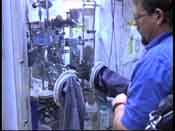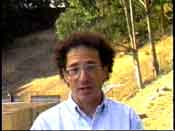 Radioactive Berkeley: Pathway to Exposure video
presentation Radioactive Berkeley: Pathway to Exposure video
presentation
Gene
Bernardi:
The National Tritium Labeling Facility is located next to an eucalyptus
grove on the west slope of Strawberry Canyon, next to the Lawrence Hall
of Science, a children’s museum. Every year, tens of thousands
of Bay area school children are exposed to the radioactive emissions
from the stack of the National Tritium Labeling Facility at the Lawrence
Berkeley National Laboratories.
 Hello, I am Gene Bernardi, co-chair of the Committee to Minimize Toxic
Waste, a grandmother and a member of the Tritium Issues Workgroup. The
Tritium Issues Workgroup was established almost two years ago to investigate
the lab’s controversial tritium releases from the National Tritium
Labeling Facility. I became involved because I live next to Strawberry
Canyon where the National Tritium Labeling Facility is located, and
I remained involved because I am concerned about our children and our
children’s children. Radioactivity not only causes cancer, but
it causes genetic mutations, and these can show up one or two generations
later. Hello, I am Gene Bernardi, co-chair of the Committee to Minimize Toxic
Waste, a grandmother and a member of the Tritium Issues Workgroup. The
Tritium Issues Workgroup was established almost two years ago to investigate
the lab’s controversial tritium releases from the National Tritium
Labeling Facility. I became involved because I live next to Strawberry
Canyon where the National Tritium Labeling Facility is located, and
I remained involved because I am concerned about our children and our
children’s children. Radioactivity not only causes cancer, but
it causes genetic mutations, and these can show up one or two generations
later.
We are here at the Lawrence Hall of Science next to the National Tritium
Labeling Facility so you can get a better idea of the lab’s radioactive
emissions and the serious health risk they pose. Let’s begin by
examining the question “Where do the radioactive emissions of
Tritium go. We can do this by looking at the operations of the Tritium
Labeling Facility.
 Marion
Fulk: Marion
Fulk:
Hello, I am Marion Fulk, a retiree from the Lawrence Livermore National
Laboratory. Tritium is a radioactive form of hydrogen. It is hard to
handle, and it’s very hard to reclaim because it soluble and will
diffuse through practically everything. It’s dangerous to children
and unborn children. It does all the biological damage that gamma rays
and x-rays do, but with greater efficiency. Tritium is released from
the Tritium Labeling Facility, then it travels through the through the
trunk and up the stack. It is then discharged into the environment as
tritiated water and absorbed by the vegetation, soil, water, and wildlife.
Dale Nesbeitt:
I’am Dale Nesbitt. I worked here at Lawrence Berkeley Lab for
some fourteen years, retired about five years ago. And much of that
time, particularly the late 1980s, I spent the majority of my working
hours right in front of me here at the machine shop. I always ate my
lunch out here under the eucalyptus trees at noontime. There have been
many accidental releases, as well as routine, at the tritium facility
since its construction its construction in the early 1960s. Releases
have been reduced in the last three years as operations were drastically
cut. However, an accident almost two months ago revealed that the tritium
lab was incinerating a large volume of its mixed radioactive waste.
 We
are here at the tritium lab site to specifically look at its air emissions
because they represent the most serious pathway to exposure. As you
can see, the tritium stack is in a grove of trees midway up the hill
from the Lawrence Hall of Science and Tritium Labeling Facility. Simply
put, the children’s museum is downwind from the stack and so,
is in a direct line of exposure. A look at this tritium plume also verifies
this fact. It is also suggests an exposure scenario that when the radioactive
emissions are released, they concentrate on the hill, slowed by the
trees, just below the Lawrence Hall of Science. When the wind blows,
this radioactive cloud passes through the Lawrence Hall of Science area
and into Blackberry Canyon and Creek. We
are here at the tritium lab site to specifically look at its air emissions
because they represent the most serious pathway to exposure. As you
can see, the tritium stack is in a grove of trees midway up the hill
from the Lawrence Hall of Science and Tritium Labeling Facility. Simply
put, the children’s museum is downwind from the stack and so,
is in a direct line of exposure. A look at this tritium plume also verifies
this fact. It is also suggests an exposure scenario that when the radioactive
emissions are released, they concentrate on the hill, slowed by the
trees, just below the Lawrence Hall of Science. When the wind blows,
this radioactive cloud passes through the Lawrence Hall of Science area
and into Blackberry Canyon and Creek.
 This
environmental data directly contradicts the parameters used by the Lawrence
Berkeley National Laboratory in their CAP’88 dispersion model.
And some other obvious misrepresentations are: This
environmental data directly contradicts the parameters used by the Lawrence
Berkeley National Laboratory in their CAP’88 dispersion model.
And some other obvious misrepresentations are:
1. Wind speed and direction, that is, toward the Lawrence Hall of Science
2. Stack height
3. The stack emission rate
What is it really?
Dr.
Leticia Menchaca
 I pointed out that, perhaps, the reason we find higher tritium concentrations
to the north and west of the tritium stack is because the wind predominately
blows in that direction. In the air, tritiated vapor will be preferentially
trapped towards the north and west of the tritium stack and deposited
on the surfaces in this area. These trees do interact with the tritiated
water in a way which they help take out of the soil, in the groundwater,
and put it into the atmosphere as well as they (trees) help trap it
from the atmosphere and put it into the soil. I pointed out that, perhaps, the reason we find higher tritium concentrations
to the north and west of the tritium stack is because the wind predominately
blows in that direction. In the air, tritiated vapor will be preferentially
trapped towards the north and west of the tritium stack and deposited
on the surfaces in this area. These trees do interact with the tritiated
water in a way which they help take out of the soil, in the groundwater,
and put it into the atmosphere as well as they (trees) help trap it
from the atmosphere and put it into the soil.
Note: Dr Menchaca filed a grievance when
LBNL did not renew her contract She was told that...
Her data and reports were “non existent”.
She couldn’t publish or talk about her work as a researcher at
the lab.
Her recent reports were all shredded.
 Bradley
Angel Bradley
Angel
My name is Bradley Angel. I am the executive director of Green Action,
and we are a Bay Area based organization working throughout the southwest
United States on issues of health and the environment. When the United
States Environmental Protection comes to Berkeley and assures concerned
residents and assures concerned elected officials, that there is no
threat, that emissions from the Lab are under control, we would encourage
people to take a long look at that because recent experiences shows
that the claims by US EPA and the assurances given to another community
here in Alameda County were not true. The community was misled; the
community was poisoned by emissions from an incinerator that the US
EPA had stated had no emissions.
Dale
Nesbitt:
 The laboratory truly has nothing to hide if, as they claim, that there’s
absolutely no danger from this facility, then they should welcome a
scientifically qualified, outside organization, one that’s truly
independent, to come and make a review of all the historic records and
all the present procedures so that the public can understand what the
dangers are presently, what they have been in the past. The laboratory truly has nothing to hide if, as they claim, that there’s
absolutely no danger from this facility, then they should welcome a
scientifically qualified, outside organization, one that’s truly
independent, to come and make a review of all the historic records and
all the present procedures so that the public can understand what the
dangers are presently, what they have been in the past.
It has to be truly an organization that has no financial ties or commitments
to government. The EPA’s Superfund evaluation quandary does make
it clear that a return to the past operating levels would once again
create a severe environmental condition at the Lawrence Hall of Science
and make it an undeniable Superfund site. We feel that the Tritium Labeling
facility should be moved to a more suitable location.
Helen Caldicott:
Young people, and babies and children in particular, are ten to twenty
times more sensitive to radiation than adults. They get it much more
readily. And here these lovely young things, you know, going to the
university, and they’re enveloped by tritium sometimes. They let
out the other day nearly twenty-three curies. A curie is a huge amount
of tritium. The EPA said the other day that it should be a Superfund
site, but they wouldn’t make it a Superfund site because they
weren’t sure it should be a Superfund site, but it  should be a
Superfund site. It’s all very contorted language. should be a
Superfund site. It’s all very contorted language.
According
to the EPA Superfund re-evaluation, 43% of the ambient air samples taken
inside the Lawrence Hall of Science in 1995 exceeded EPA Cancer Risk
Screening Concentration for tritium. So the tritium is sucked into the
Lawrence Hall of Science where not just hundreds, thousands of children
are taken there all the time, you know, every year. This is criminal!
These people should be put in jail! |
